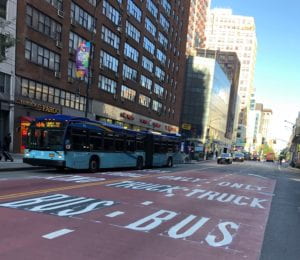By Lauren Roland, MUP ’21
In September 2018, the average bus ride between third and ninth avenues was 15 minutes. After NYC Department of Transportation ro lled out the 14th street busway, the average bus ride is now 10 minutes between those avenues. Ridership has increased from 26,000 daily riders in September 2018 to 31,000 daily riders in October 2019.
lled out the 14th street busway, the average bus ride is now 10 minutes between those avenues. Ridership has increased from 26,000 daily riders in September 2018 to 31,000 daily riders in October 2019.
The rollout (originally scheduled to begin July 1) was initially met with hostility and controversy. Local residents of surrounding streets even sued the DOT, claiming the busway would divert traffic and clog other streets around 14th Street, making the quality of life and traffic unbearable. Despite this, the busway finally debuted after a five-judge state appellate court lifted a temporary restraining order on the plan. Residents, it turns out, had little to fear., On October 16, 2019, the traffic and data analytics firm, INRIX, revealed that most of the traffic speeds along these roads have not changed at all, with the exception of a small increase on 16th Street, where travel time only increased by 23 seconds due to slower traffic speeds.
Indeed, the success of the rollout has prompted several officials, including NYCTA President Andy Byford to consider future ‘bus-only’ streets for the city. Several bus-only streets would echo the dream of a ‘car-free’ city mentioned in Canadian urbanist Charles Montgomery’s book ‘Happy City’ in which the author explains that in order to make cities function better and improve the quality of life, we must get rid of cars altogether.
Cars ultimately pose a threat to pedestrians and cyclists alike, as well as disturb the peace for residents in their homes due to honking, yelling and traffic. A truly “car-free” city would enable pedestrians to walk freely, cyclists to ride safely, residents to enjoy the quiet in their homes. Building a ‘car-free’ city would require public transportation needs to be fully met, including reliable buses and subways and greater coverage in transportation ‘deserts’. We have a long way to go before these criteria are met, but adding “bus-only” streets is a good start.
The success of the 14th Street Busway has shown us that when we put the needs of transit riders and pedestrians, ahead of the needs of drivers, we can create a city that is much easier to navigate. Streets that are ‘walk-only’ (as in the case of some surrounding streets in Times Square) or ‘bus-only’ are the start of a new way of thinking of how we move around dense cities. For a long time, cars have been hailed as the best way to move around (especially in more sprawling areas); however, small changes such as the 14th Street Busway prove that we can successfully move people without relying on cars and noisy streets.